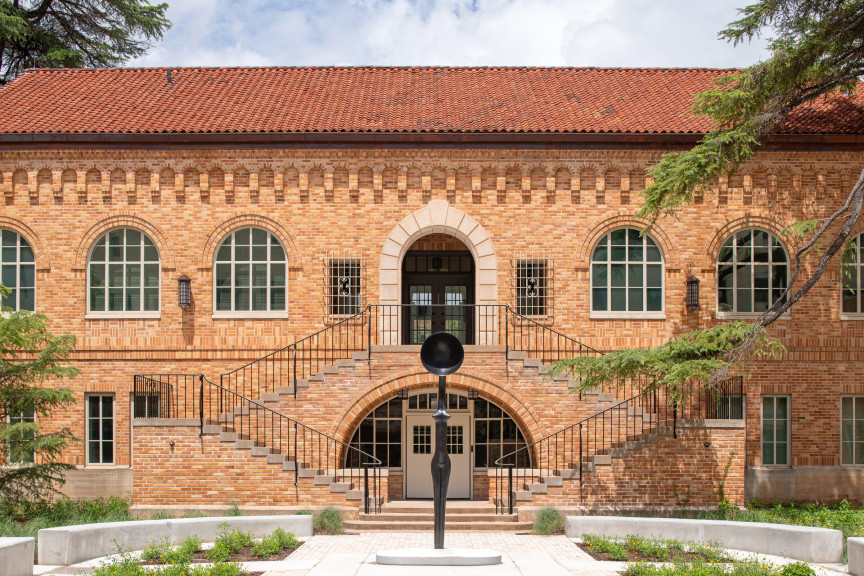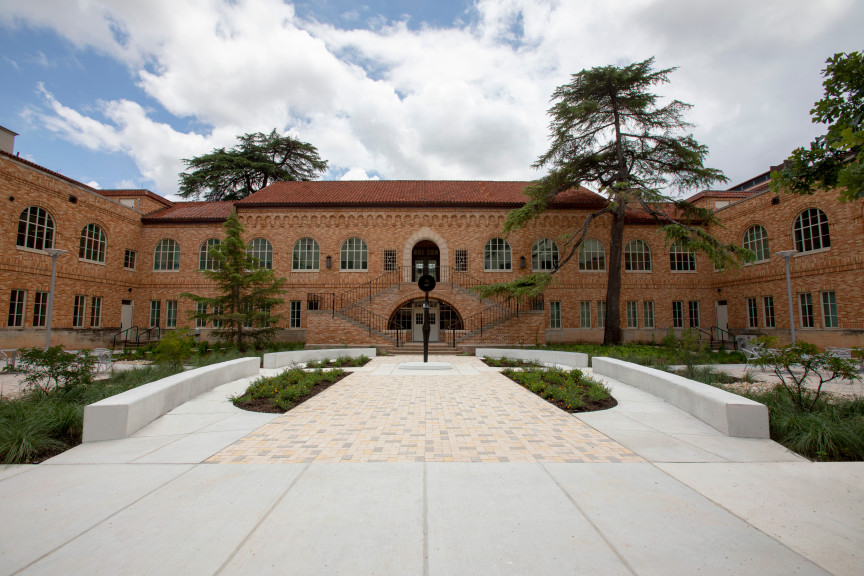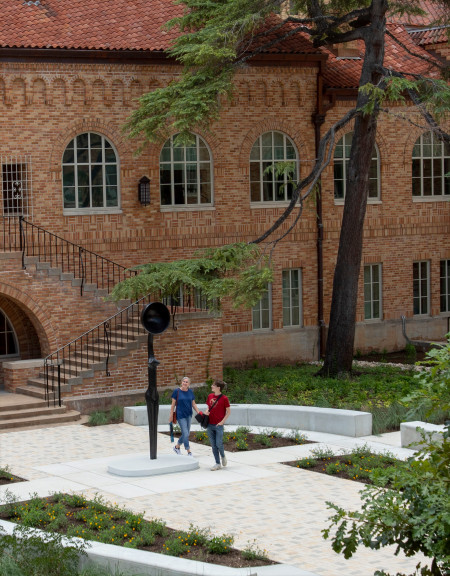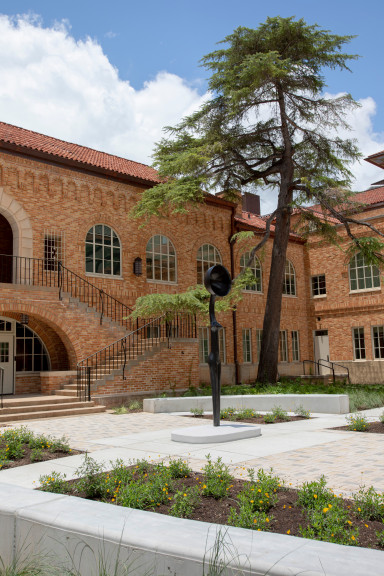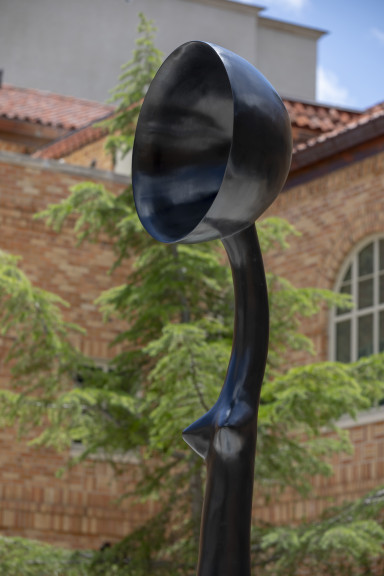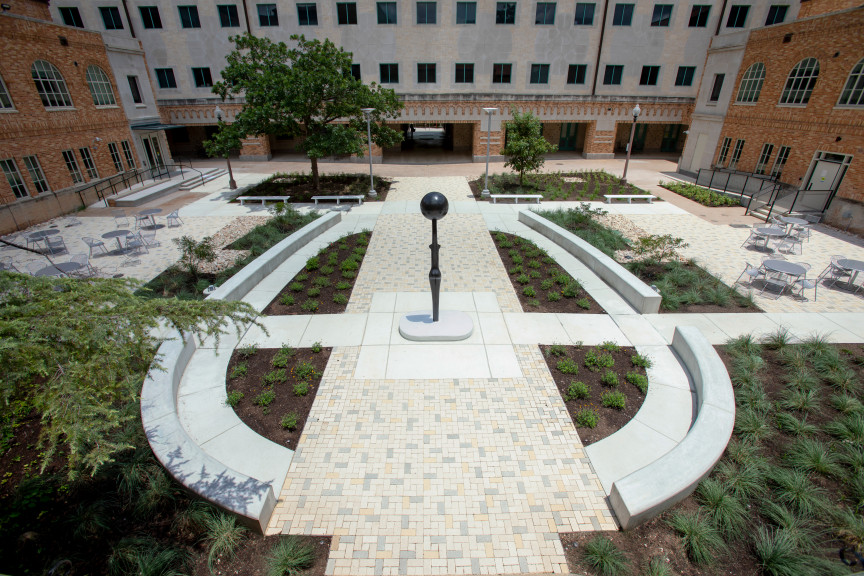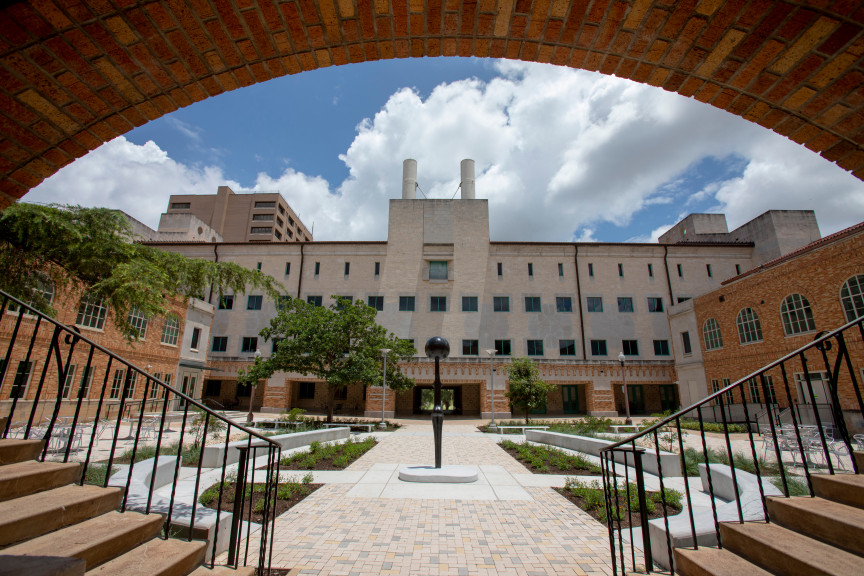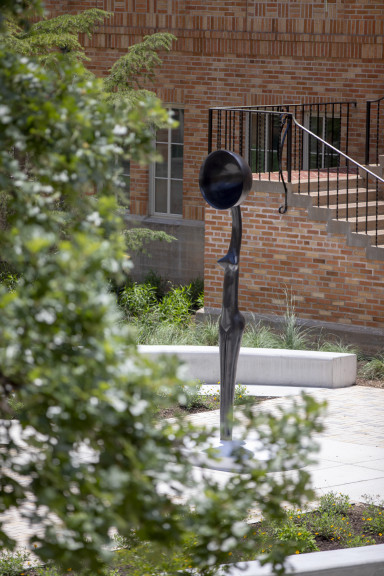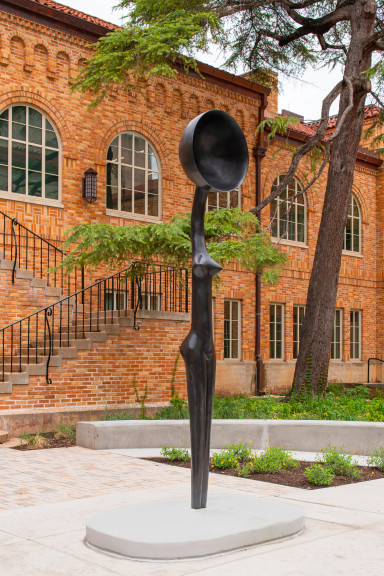Sentinel IV
Simone Leigh
128 × 25 × 15 inches
Purchase, Landmarks, The University of Texas at Austin, 2020
GPS: 30.28855, -97.73785
Simone Leigh uses sculpture, video, installation, and performance art to explore representations of Black feminine forms. Her work draws upon the African diaspora — encompassing cultures and peoples originating from Africa and dispersed across the globe through both forced and voluntary means. Within this framework, Leigh appropriates visual traditions from Africa, the American South, and the Caribbean to create works that reflect the layered histories, identities, and experiences of the diaspora.
Leigh began her artistic career during her college years. While studying philosophy, she took a ceramics class on a whim. She soon developed proficiency in pottery techniques, despite never having attended art school. Her early interest in issues of race and beauty inspired exquisite sculptures of Black women that would later manifest as Leigh’s renowned creolization of forms.
Her sculptures are often anthropomorphic, fusing Black female figures with domestic objects or tools, and occasional modern references. Sentinel IV is modeled after a Zulu ceremonial spoon, a symbol of status and women’s labor within Zulu culture. In taking inspiration from figurative sculpture across the African diaspora, Leigh chooses to represent not a single individual, but rather the collective power of the Black female body more broadly.
Sentinel IV is a slender bronze guardian with elongated proportions and a faceless bowl crown that emanates a mystical presence. In using the term “sentinel” — a watchful guardian — Leigh honors Black femininity while also investigating historical and intersecting ideas of race, beauty, and the association of Black women’s bodies with work.
Sited in the central courtyard of the Anna Hiss Gymnasium, Sentinel IV stakes radical claim in a moment when Black existence remains under threat. It holds space and holds court — an apt landmark poised to see, hear, and represent — to project Black presence into the future of The University of Texas at Austin, bearing witness to this indelible present.
ACTIVITY GUIDES
Sentinel IV
Simone Leigh
Subject: Proportions of objects
Activity: Abstracted still life
Materials: Object of choice, three pieces of 8.5 x 11 paper, pencil, acrylic paint (or other coloring materials of your choice)
Vocabulary: Ceremonial, commemorative, proportions, ritual, replica, sentinel, triptych
Simone Leigh’s sculpture is inspired by West and South African traditions. Sentinel IV, her work for Landmarks, is modeled after a Zulu ceremonial spoon used in wedding ceremonies. Representing the joining of two families, the wooden object is kept and displayed in the married couple’s home. The sculpture is also inspired by a sentinel, or guard, who stands watch over and protects people.
Sentinel IV is slender bronze guardian with elongated proportions and a faceless bowl crown. It is a combination of a watchful guardian and the Zulu spoon that celebrates marriage.
Can you think of any ceremonial, spiritual, or commemorative objects in your life?
What is a ritual in your life? What objects do you use for it?
Are the proportions in Sentinel IV true to life?
Look at the sculpture solely as a spoon, and then solely as a person. What human-like qualities have been modified to look like a spoon? What spoon-like qualities have been modified to look like a human?
Think of ritual object that is special to you. It could also be an object you use in your everyday life. Start by drawing your object, exactly as it is. What are some qualities your object has? What qualities of your object are important for it to be recognizable? For your next two drawings, change the proportions of your object in different ways. How different can you make your object look from your original drawing? Add color to your drawings using acrylic paint.
Replicas of the Zulu ceremonial spoon that inspired Leigh’s sculpture can be bought by tourists visiting the region of Southern Africa (notably the KwaZulu-Natal province). The spoon is so popular that miniature plastic replicas can also be purchased online.
Leigh celebrates Black women with her work. Sentinel IV is a larger-than-life celebration of Black women who protect their families and culture.
Does the sculpture seem grand to you? Look back at your drawings. Do they celebrate certain people? Why is it important to celebrate them?
Ceremonial ‒ Something that is a part of or used for a religious or public event
Commemorative ‒ Acting as a memorial or mark of an event or person
Proportions ‒ A part, share, or number considered in comparative relation to a whole. The dimensions of a composition and relationships between height, width and depth
Ritual ‒ A repeated activity or movement during a religious or important event
Replica ‒ Copies of an original work that can be mass produced and are often less expensive and detailed than the original
Sentinel ‒ A guardian whose job is to keep watch
Sentinel IV
Simone Leigh
Subject: Anthropomorphic sculpture
Activity: Creating sculptures that reimagine everyday objects as anthropomorphic
Materials: Clay or similar material (model magic airdry clay, etc), pencil
Vocabulary: Ceremonial, commemorative, ritual, sentinel, replica, anthropomorphism
Simone Leigh’s work is inspired by and honors spiritual and ceremonial objects of West and South Africa. Sentinel IV is modeled after a Zulu spoon often used in wedding ceremonies to signify the joining of two families. The wooden object is meant to signify family integration, or the bride entering into the husband’s home.
Leigh’s practice is informed by her interest in Black feminine subjectivity, and Sentinel IV is a larger-than-life abstract Black female form. It showcases the power and beauty of Black femininity while also questioning the use and creation of ritualized objects and the belief systems they uphold.
Can you think of any ceremonial or spiritual objects in your life?
When and how do you use them?
Why is it important?
How do these objects reflect your own culture, beliefs, or traditions?
Think of an object in your life that makes you feel protected and safe. Sculpt the object using clay. Use a pencil to add decorative elements. Try and imagine what your sculpture would look like as a person. Can you make your object an anthropomorphic sculpture?
Leigh has many other sculptures that are inspired by the Zulu ceremonial spoon. One of these, Sentinel (Mami Wata) (2020–21), is located in New Orleans, and stands at the former site of a con- federate monument. Leigh sold 25 miniature versions of this sculpture and donated the proceeds to Color of Change, a nonprofit organization that advocates for racial justice. The artist also exhibited a larger version when she represented the United States at the Venice Biennale in 2022.
How do you think Leigh’s sculpture references her original object, a spoon? How is it similar? How is it different?
Look back at your sculpture. How would you feel if other people could buy plastic replicas of your ritual object?
Ceremonial ‒ Something that is a part of or used for a religious or public event
Commemorative ‒ Acting as a memorial or mark of an event or person
Ritual ‒ A repeated activity or movement during a religious or important event
Sentinel ‒ A guard whose job is to keep watch
Replica ‒ Copies of an original work that can be mass produced and are often less expensive and detailed than the original
Anthropomorphism ‒ The attribution of human characteristics or behavior to a god, animal, or object
Sentinel IV
Simone Leigh
Subject: Found objects and scale
Activity: Sculpting and re-imagining everyday objects in a new scale
Materials: Clay or similar material (model magic airdry clay, etc)
Vocabulary: Ceremonial, sentinel, scale, Zulu
Leigh’s sculpture is inspired by West and South African traditions. She made the sculpture to look like a wooden ceremonial spoon. Weddings are important for the joining of two families, and these spoons are a special part of Zulu weddings. After the wedding ceremony, the wooden object is saved and displayed in the married family’s home.
The sculpture is also inspired by a sentinel, a guard who stands watch and protects people. In Sentinel IV, Leigh combines the two objects, a watchful guardian and a ceremonial spoon that celebrates marriage.
Can you think of any objects in your home that are saved from important events?
When and how do you use them?
Why is it important?
Sculpt an object of your choice using clay. It can be anything you want: something you like, something you use every day, or something important to you. Change the way your object looks by making your sculpture bigger or smaller than the actual object.
Leigh celebrates Black women with her work. Sentinel IV is a larger-than-life celebration of Black women who protect their families and culture.
Does the sculpture seem like a protector to you? Look back at your sculpture - is it also celebrating certain people? Why is it important to celebrate them?
Ceremonial ‒ Something that is a part of or used for a religious or public event
Scale ‒ The overall physical size of an artwork or objects in the artwork
Sentinel ‒ A guard whose job is to keep watch and protect people
Zulu ‒ An ethnic group in Southern Africa. The Zulu people are the largest ethnic group and nation in South Africa, with an estimated 10–12 million people, living mainly in the province of KwaZulu-Natal.
MORE INFORMATION
Sentinel IV, 2020
Monumental in scale, Simone Leigh’s Sentinel IV is silent, still, rooted. At ten-and-a-half feet tall, this slender guardian with its elongated proportions and faceless bowl crown exudes a mystical presence. Bronze becomes sentient in Leigh’s hands—the smooth, black, semi-reflective surface glistens radiantly where it stands in the Anna Hiss Gymnasium courtyard. Despite its featureless façade, Sentinel IV seems to capture and hold vision itself in its deep hollow. The anthropomorphic figure at once holds space and holds court, to use two vernacular concepts in tension—to make space/to take up space.
Over the past decade, Simone Leigh has used sculpture, video, installation, social practice, and performance as critical means through which to pursue and amplify representations of Black feminine forms and to celebrate and serve her primary audience—those who identify as Black women. Drawing upon the quotidian visual traditions across the African continent, American south, and Caribbean, Leigh’s sculptural work in particular engages with diverse Black cultural histories and complex experiences across the diaspora.
Leigh began her artistic career when she took a ceramics class on a whim while studying philosophy in college. She soon discovered a knack for clay and developed proficiency in pottery techniques despite never attending art school. Leigh’s early interest in issues of race and beauty inspired exquisite sculptures of Black women, artworks that saw her now renowned creolization of form perfected.
Over the course of her career, explorations of architecture, history, and Black female figures have catalyzed some of her most profound work, including Loophole of Retreat (2019) at the Solomon R. Guggenheim Museum, and Brick House (2019), commissioned for the High Line Plinth in New York City. Each piece is meticulously researched—the conceptual heft of the artist’s work only outdone by the forms themselves, which range according to her many rich influences. Scholar and cultural theorist Christina Sharpe, poet Dionne Brand, abolitionist Harriet Jacobs, feminist conceptual artist Lorraine O’Grady, sculptor Nancy Elizabeth Prophet, and African American studies scholar Saidiya Hartman, are but a few of the sculptor’s intellectual and creative interlocutors. Leigh has also drawn inspiration from sources as wide-ranging as colonial anthropology, fundamentalist Christianity, and 1970s Afrocentrism.
Given her emergence in the wake of postminimalist sculpture and postmodern artistic sensibilities more broadly, the cultural legacy to which Leigh’s work belongs is part of “a respected lineage of artists who are oriented towards feminist and civil rights activist discourses, such as Faith Ringgold, Barbara-Chase-Riboud, Noah Purifoy, and Miriam Schapiro,” as noted by curator Jamillah James. She argues that, “by centering black women as subjects and audience, Leigh forges her own sense of time that is constantly navigating various histories, while contending with the present and with possible futures.”
Today, Leigh is celebrated for her deep formal investigations into familiar objects, which she reworks in order to destabilize their original signs and connotations. Whether breast fetishes, enlarged cowry shells, or glazed stoneware inspired by antebellum South Carolinian face vessels, these objects represent Leigh’s sustained meditations on Black women and their bodies as a kind of material culture—to use the artist’s words—and as containers for history, trauma, and knowledge. In some of her best-known works, which include the ceramic busts in her ongoing Anatomy of Architecture series (2016), Leigh depicts Black women with exceptionally intricate bodices, ornate floral diadems, and smooth flat surfaces in place of their eyes.
Departing from classical portrait busts, Leigh’s pieces take their inspiration from figurative sculpture across the African diaspora and represent no single individual, but rather exude Black female subjectivity broadly. They are sculpted using dark, richly hued, and textured surfaces, a stark contrast to the historical use of smooth white marble. Artist Lorraine O’Grady describes her first encounter with Leigh’s “women without eyes, these blind women,” as frightening. Upon further reflection, however, the conceptual artist notes the radical and self-preservationist impulse that can be read in Leigh’s formal approach to her sculpture’s eyes, recognizing the lack of eyes—this blinding—as an opportunity to look inside and to see oneself more clearly.
Leigh describes her own approach to Black women as cultural objects through the language of auto-ethnography, the study of communities to which the scholar or artist belongs. The native anthropologist uses their own orientation and access to observe and amplify perspectives typically marginalized. Indeed, one can observe how the artist’s practice is deeply informed by research and participant observation, the work itself produced out of self-reflexive modes of engagement in projects such as The Free People’s Medical Clinic (2014), The Waiting Room (2016), and Loophole of Retreat (2019). Furthermore, this process is both auto-ethnographic in its orientation to the various archives and communities Leigh traverses, as well as phenomenological in its fabrication, as sculpture is necessarily a medium one negotiates in relationship to their own body, both as maker and spectator.
In her more recent work, Leigh explores the Black female form through its material and cultural associations with notions of labor, specifically objects that amalgamate the body with tools for everyday use. Bringing together the Black female body and material culture, the artist focuses on vernacular objects found across the African diaspora that she understands as readymades. In this way, Leigh revisits the modernist cannon as a way to assert a Black female presence; however, significantly, the artist remains untethered by modernist definitions and rules. In Leigh’s practice, these bodies and their existence are strategically disentangled from notions of European whiteness, an impulse emanating from a lineage of artists working during the civil rights, black power, and feminist movements of the 1960s and 1970s.
The figure of Sentinel IV is one such cultural readymade, and is likely familiar to those who have traveled to South Africa in the last several decades. Used as a ceremonial spoon in its original context, this nineteenth- and early twentieth-century object became popular among tourists drawn to its stunning artistry and portability. In fact, the New York Times and other travel columns catering to international travelers often feature spoons like the ones that inspired Sentinel IV in their destination articles and souvenir guides.
Meant to represent feminine beauty and sensuality, the carved form originated in its use as ceremonial cutlery often accompanying other Zulu wedding rituals. The wooden object, notably anthropomorphized in female form, is the traditional instrument of familial integration, signifying the bride’s entry into her husband’s family and home. It is customary for the spoon to be kept in a woven satchel especially designed and beaded to hold such objects; however, those found in regional tourist shops are often displayed upright, supported by tiny stands. The souvenirs range in size from a few inches to several feet, with designs varying from wide brimmed bowls and thick, beaded stem handles, to delicate, sinuous, and anthropomorphic stems with circular pitted bowls.
The artist’s interest in the history of the African diaspora stems from her fascination with these vernacular objects, and the spoon is one such iconic object in West and South African culture. In many of the earliest ritual spoons, such as ones exhibited at the Louvre Museum in Paris and at the Smithsonian Museum of Natural History in Washington, DC, the carved wooden figure is rendered in exquisite detail, complete with intricately defined anatomical parts. Each figure’s cone-shaped breasts, which typically point in opposite directions, also call to mind other objects across continental Africa that celebrate feminine sensuality and fertility.
Indeed, Leigh is not the first artist inspired by African ceremonial spoons. In fact, the Swiss sculptor Alberto Giacometti sculpted his own bronze iteration titled Spoon Woman (1926–27) after ceremonial spoons carved by the Dan people of West Africa. However, the title of Leigh’s sculpture is not entirely didactic. Leigh admits that in actuality all of her works might be called “sentinels”—her use of sentinel acknowledging the persistent labor performed by the Black female form, even when elevated and presented in fine art contexts. With this powerful charge, Leigh names Sentinel IV for its position across expansive historical and cultural milieus, an especially fitting attribution in its current university context.
The artist’s appropriation of the spoon in Sentinel IV subverts its cultural manifestation as an object requiring activation through ceremonial use to receive its power, or commercial exchange to receive its value. Said another way, the Black female form in Leigh’s sculptural practice is transformed into an aesthetic object to be looked at and admired, rather than touched and used, despite its legacy use and its proliferation as a monetized and exported trinket. Leigh simultaneously liberates the Black female form in this instance from a cycle as a ritual implement, and propels this same form into the commercial context of the fine art world. How will this form be read and understood today in its new hypervisible context?
On a campus, in a city, whose own history continues to be shaped by exclusion, violence, and segregation, Leigh’s sentinel stakes radical claim to existence in a moment when Black existence, in particular, is persistently under threat. Sentinel IV holds space and holds court—an apt landmark poised to see, hear, and represent—to project Black presence into the future of The University of Texas at Austin and beyond, while bearing witness to this indelible present.
With thanks to Relyn Myrthil for her research assistance.
Stephanie Sparling Williams
Simone Leigh bibliography
Li, Dixon. “Of Monuments and Black WOMEN'S Monumental LABORS—MONUMENT LAB[k1] ,”
Hartman, Saidiya. The Anarchy of Colored Girls Assembled in a Riotous Manner, edited by Solomon R. Guggenheim Museum. New York: W. W. Norton & Company, Inc., 2019. https://monumentlab.com/bulletin/of-monuments-and-black-womens-monumental-labors.
Parker, Rianna Jade. “'What We Carry in the Flesh': The Majestic Bodies of Simone Leigh.” Frieze. June 4, 2019. https://www.frieze.com/article/what-we-carry-flesh-majestic-bodies-simone-leigh.
Molesworth, Helen. “Art is Medicine: Helen Molesworth on the Work of Simone Leigh.” Artforum International, March 1, 2018. https://www.artforum.com/print/201803/helen-molesworth-on-the-work-of-simone-leigh-74304.
Nelson, Charmine. The Color of Stone: Sculpting the Black Female Subject in Nineteenth-century America. University of Minnesota Press, 2007. https://www.upress.umn.edu/book-division/books/the-color-of-stone.
Jackson, Zakiyyah Iman. “Suspended Munition: Mereology, Morphology, and the Mammary Biopolitics of Transmission in Simone Leigh’s Trophallaxis.” efflux 105 (December 2019). https://www.e-flux.com/journal/105/305272/suspended-munition-mereology-morphology-and-the-mammary-biopolitics-of-transmission-in-simone-leigh-s-trophallaxis/.
Osmundson, Joe. “How Many Black Histories We Still Don’t Know: An Interview With Simone Leigh.” The Feminist Wire, October 3, 2014. https://thefeministwire.com/2014/10/many-black-histories-still-dont-know-interview-simone-leigh/.
Landmarks acquired Sentinel IV by Simone Leigh to grace the courtyard of the Anna Hiss Gymnasium and offer opportunities for reflection and engagement. The sculpture honors Black femininity while also investigating historical and intersecting ideas of race, beauty, and the association of Black women’s bodies with work.
Funding for Sentinel IV was provided by the capital improvement project for the Anna Hiss Gymnasium. Landmarks gives special thanks to the following:
Leadership
Darrell Bazzell and Financial and Administrative Services
Andrée Bober and Landmarks
Michael Carmagnola and Project Management and Construction Services
Campus Master Planning Committee
David Darling and the Office of Campus Planning and Facilities Management
Jay Hartzell and the Office of the President
Landmarks Advisory Committee
Ramón Rivera-Servera and the College of Fine Arts
Larry Singell and the Office of the Executive Vice President and Provost
Project Team
Asakura Robinson, landscape architecture
Andrée Bober, curator and director, Landmarks
Nisa Barger, project manager, Landmarks
Robert Hengst, Project Management and Construction Services
Ross Johnson, Office of the Executive Vice President and Provost
Simone Leigh, artist
Lord Aeck Sargent, architecture
Patrick Sheehy Fine Art Services, art installation
SpawGlass, construction
Special Thanks
Rebecca Adib, Simone Leigh Studio
Megan Ardery, Resnicow + Associates
Paul Bardagjy, photography
Eboné Bishop, Evolv Culture
Christina Cary, Hauser & Wirth
Douglas Dempster, former dean, College of Fine Arts
Claire Eddleman-Heath, Asakura Robinson
André Fuqua, development, Landmarks
Christine Gwillim, education, Landmarks
Bill Haddad, technology
Andrea Keane, event planner, Landmarks
Mary Margaret Kennedy, operations, Landmarks
John Kisner, Lord Aeck Sargent
Logan Larsen, communications, Landmarks
Margaret-Anne Logan, Resnicow + Associates
Marla Martinez, Financial and Administrative Services
Maurie McInnis, former Executive Vice President and Provost
Alexandra Mendez, intern, Landmarks
Christina Murrey, photography
Relyn Myrthil, research assistant
Sophie Treharne Nurse, Hauser & Wirth
David Resnicow, Resnicow + Associates
Margaret Robinson, Asakura Robinson
Linda Shaunessy, Business Contracts
Cherise Smith, African and African Diaspora Studies
John Starr, Lord Aeck Sargent
Kathleen Brady Stimpert, deputy director, Landmarks
Stephanie Taparauskas, development, Landmarks
Vault Fine Art Services
Stephanie Sparling Williams, curatorial contributor
Christine Wong, College of Fine Arts
Reagan Woodlock, design, Landmarks
Ali Wysopal, collections, Landmarks
John Yancey, Fine Arts Diversity Council

